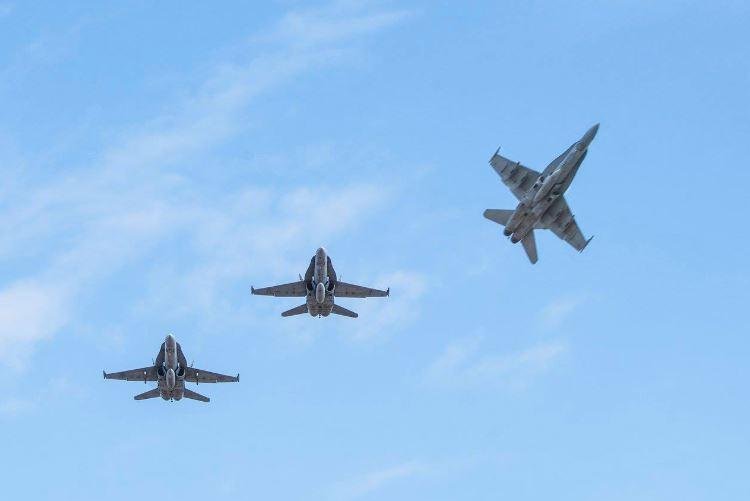1 of 2 | The last operational F/A-18C Hornet squadron took flight over Naval Air Station Oceana in Virginia Beach, Va., on Friday. Photo by Naval Air Station Oceana/Facebook
Feb. 5 (UPI) -- During a sundown ceremony, the last operational F/A-18C Hornet squadron took flight over Naval Air Station Oceana in Virginia Beach, Va., as the military transitions to new jets.
The "Blue Blasters," the lone Hornet squadron that has not transitioned to Boeing's F/A-18E Super Hornet, took flight on Feb. 1, the Navy announced on Monday.
The Navy has flown the Hornet since 1978, including deploying the F/A-18A/B Hornet in 1983 and the upgraded F-18C/D model in 1987. The larger F/A-18E/F Super Hornet has flown since 1999.
The remaining single-seat, twin-engine, supersonic Hornets took their last flight with Strike Fighter Squadron 34, taking a longer route on their final flight -- including near the First Flight Memorial near Kitty Hawk, N.C. The F/A-18 Hornet is the nation's first strike-fighter serving in a dual role as attack aircraft and fighter for air-to-air combat.
"The Hornet is known as many things," Cmdr. William Mathis, commanding officer of VFA-34, said during the ceremony. "Legacy, highly reliable, multi-role attack fighter... but to us, she will always be an old friend. ... For the operational Navy, it is time to say goodbye. So from the men and women who flew and maintained the legendary F-18 Hornet, we say thank you for your service and job well done."
The F-18 won't be totally out of service. They'll still be used by Navy reservists playing the role of adversary aviators. And the U.S. Marine Corps plan on still flying flying their F/A-18Cs until 2030 when the F-35B Joint Strike Fighter replaces them.
VFA-34 will receive F/A-18E jets from Boeing's manufacturing plant in St. Louis.
In 2016, the VFA-34 was announced as the squadron to conduct the last legacy Hornet operational deployment.
Along with the rest of Carrier Air Wing 2 aboard USS Carl Vinson, the squadron left San Diego in January 2017 for the Western Pacific.
Vinson again deployed in January 2018 for a few months, which included a historic port call in Vietnam.
In October, they recorded their last carrier qualifications with the jets, Naval Air Forces Atlantic spokesman Cmdr. Dave Hecht. told Navy Times.
The carrier returned home to San Diego for a few months and then headed west again for the Rim of the Pacific 2018 exercise in Hawaii for a three-month tour that ended in April.
"That's it, you're not going to see a Hornet on an aircraft carrier -- at least with U.S. Navy paint on it - ever again," Lt. Kevin Frattin, a Hornet pilot and assistant operations officer in VFA-34, told USNI News.
Frattin had only flown the Hornet, not the Super Hornet.
"We have some unique capabilities that, I'm wondering who's going to pick up the slack when we're not here anymore, because for some things we do we're the only ones who can do it," said Frattin, who added Hornets of late "probably require a little more TLC."
The F-18C, manufactured by McDonnell Douglas, had a flight ceiling of 50,000-plus feet with a combat range of 1,089 nautical miles, according to the U.S. Navy.















